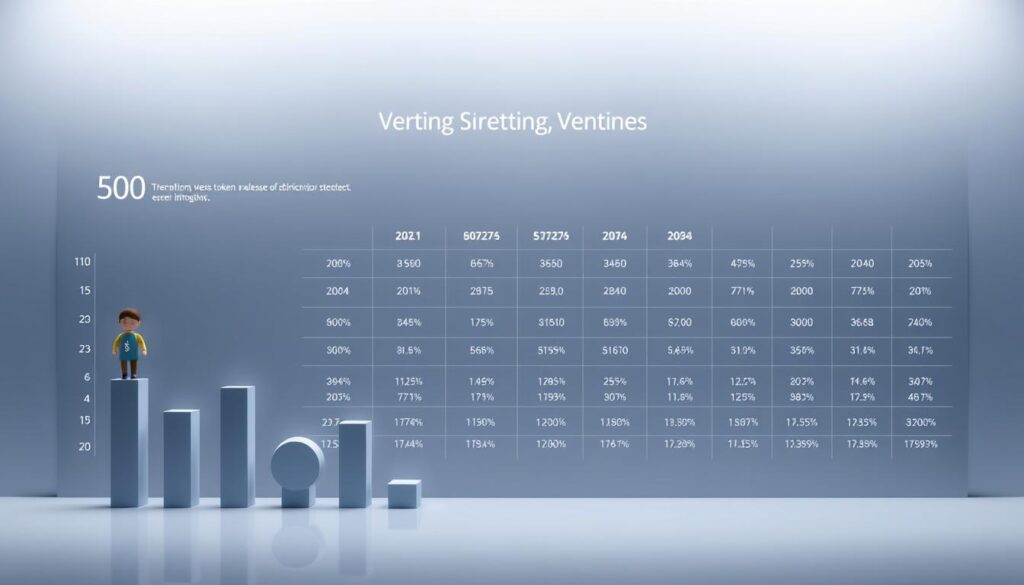Now Reading: Understanding Cryptocurrency tokenomics supply demand economics Principles
- 01
Understanding Cryptocurrency tokenomics supply demand economics Principles
Understanding Cryptocurrency tokenomics supply demand economics Principles

Every successful digital asset ecosystem rests on a solid foundation of well-designed economic principles. These rules are encoded directly into the blockchain’s protocol. They create a transparent and automated system for managing a network’s resources.
This framework, often called tokenomics, blends traditional economic theory with modern blockchain technology. It replaces centralized control with code-based governance. Understanding this economic architecture is critical for anyone involved in the crypto space.
Whether you are building a project, investing in a token, or simply analyzing digital assets, these principles determine a project’s potential. They dictate how value flows through the system and who benefits. A strong model aligns incentives for developers, investors, and users, driving growth and sustainability.
This introduction sets the stage for exploring how fundamental forces like supply and demand operate in decentralized environments. We will look beyond simple calculations to explore utility, incentives, and distribution. These elements collectively shape a token‘s path in the market.
Key Takeaways
- Digital asset ecosystems require carefully planned economic rules built into their code.
- Tokenomics combines economic theory with blockchain for transparent, automated governance.
- This economic design is vital for project builders, investors, and analysts to understand.
- A well-structured model aligns incentives and drives long-term network growth.
- Supply and demand dynamics work uniquely in decentralized systems.
- Token value is influenced by utility, distribution, and incentive mechanisms.
Introduction to Cryptocurrency Tokenomics
The term ‘tokenomics‘ itself is a portmanteau, signaling its purpose: to apply economic principles specifically to digital tokens on a blockchain. It encompasses every aspect of a digital asset’s life, from creation and distribution to its use and potential removal. This framework is vital for understanding any Web3 project.
Overview of Tokenomics in the Crypto World
This concept applies to both coins, like Bitcoin, which have their own blockchain, and tokens built on existing networks. The key difference from traditional systems is that these rules are written in code. This creates a transparent and automated economy.
Smart contracts replace central banks, executing policies with consistency. This code-based governance brings a new level of predictability to digital markets. It defines how participants interact within the ecosystem.
Importance of Economic Models for Digital Assets
A well-designed model is crucial for a network’s health. It aligns incentives for everyone involved—developers, holders, and users. Good tokenomics rewards positive contributions and secures the network.
It directly ties value creation to active participation. Strong models foster growth and resilience. In contrast, poor design can lead to a loss of confidence and value decline. Evaluating a project‘s tokenomics is therefore essential for assessing its long-term potential.
Fundamentals of Supply and Demand in Tokenomics
Understanding how availability and desire shape price is crucial, whether analyzing dollars or digital assets. The basic rules are similar, but their application differs greatly.
Comparing Traditional and Digital Systems
Traditional money, like the US dollar, has no hard cap. Central banks can create more. This often reduces its buying power over time.
In contrast, a digital asset’s creation is usually predefined by code. This brings transparency. Anyone can see the total number that will ever exist.
What people want from an asset also varies. For traditional currency, demand comes from its use in daily life and trade. For a digital token, desire is more complex.
| Feature | Traditional Fiat System | Digital Asset System |
|---|---|---|
| Supply Control | Centralized (Central Banks) | Decentralized (Smart Contracts) |
| Supply Predictability | Unpredictable, based on policy | Highly predictable, based on code |
| Primary Demand Drivers | Medium of exchange, store of value | Utility, governance, staking rewards |
| Key Influencing Factors | Interest rates, public trust | Network growth, platform usage |
This shift from human decision-making to automated rules creates a new kind of economy. It offers a clear view of future availability.
Evaluating a token‘s potential requires looking at both its creation schedule and its real-world uses. A strong model balances these elements for long-term health.
Key Components of Crypto Economic Models
Evaluating digital projects requires understanding the fundamental building blocks of their design. These components work together to create sustainable ecosystems.
Exploring Token Supply and Circulation
Different types of availability metrics help assess a project’s structure. The maximum token supply represents the absolute limit that will ever exist.
Bitcoin’s 21 million cap serves as the classic example. Circulating supply refers to tokens currently available in the market.
| Supply Type | Definition | Key Consideration |
|---|---|---|
| Maximum Supply | Total tokens that will ever exist | Creates scarcity and defines ultimate limit |
| Circulating Supply | Tokens currently available for trading | Excludes locked, reserved, or burned tokens |
| Total Supply | All tokens created by the protocol | Includes both circulating and non-circulating tokens |

Understanding Token Demand Mechanisms
User incentives drive engagement and value. Game theory principles explain rational choices based on potential benefits.
Staking and yield farming reward participants for locking assets. Active communities indicate strong belief in projects.
These mechanisms create circulation and engagement. For a deeper understanding of token economic models, explore how these components interact.
Cryptocurrency Tokenomics Supply Demand Economics: Impact on Value
Blockchain networks employ sophisticated mechanisms to influence asset valuation through programmed scarcity. These systems create predictable value accumulation by balancing creation and removal of digital assets.
Effect of Scarcity on Market Prices
Scarcity drives price appreciation when desire remains constant. Projects implement burn mechanisms to permanently reduce circulating amounts.
Solana destroys 50% of each transaction fee. BNB conducts periodic removals. These actions create artificial scarcity in the market.

| Network | Burn Mechanism | Impact on Supply |
|---|---|---|
| Solana | 50% fee destruction | Continuous reduction |
| BNB | Quarterly scheduled burns | Periodic scarcity events |
| Ethereum | EIP-1559 fee burning | Activity-dependent reduction |
Role of Smart Contracts and Transaction Fees
Automated contracts enforce economic policies without human intervention. They manage distribution and execute burns transparently.
On Ethereum, users pay gas fees in ETH for transactions. This creates organic demand for the native token. Cumulative fee collection indicates genuine network usage.
Understanding these crypto tokenomics principles helps evaluate sustainable token value. Effective models balance scarcity with sufficient availability for utility.
Utility, Incentives, and Governance in Tokenomics
The true power of digital assets lies in their practical applications and governance structures. A token’s utility represents the concrete benefits it provides to holders. This goes beyond mere speculation to create organic demand.

Real-world use cases demonstrate this principle clearly. MATIC tokens enable Polygon users to pay transaction fees. Holding 400 CODE tokens grants access to Developer DAO membership. These examples show how utility drives genuine use.
Real-World Use Cases and Network Participation
Different tokens serve distinct purposes within their ecosystem. Bitcoin functions as a store of value. Governance tokens like AAVE and UNI give holders voting rights on protocol changes.
Utility tokens provide access to services, while security tokens represent real assets. Each type creates specific incentives for participation.
Network incentives reward active contributors. Bitcoin compensates miners with fee portions. Ethereum offers rewards for validators through staking. DeFi platforms like UniSwap provide yields to liquidity providers.
Governance represents another layer of utility. Tokens enable community members to vote on upgrades and fund allocations. This distributed control strengthens the entire network.
Effective models attract genuine users rather than short-term speculators. They create sustainable demand through clear use cases and fair governance. This approach builds resilient community support for long-term value.
Token Distribution and Vesting Schedules
How digital assets are distributed among participants can make or break a project’s future. The initial allocation strategy determines who holds the tokens and when they can access them.
Projects typically divide holders into different groups. The core team, early investors, and general public each receive different allocation amounts. This structure affects long-term project stability.

Strategies for Fair Allocation
Two main launch approaches exist for token distribution. Pre-sale models allow teams to raise funds by allocating tokens to early supporters before public release.
Fair launches take a different approach. All distribution happens after going public with no privileged access. This creates more equitable participation from the start.
| Distribution Method | Key Characteristics | Impact on Market |
|---|---|---|
| Pre-Sale Allocation | Early investor access before public launch | Provides initial funding but creates early concentration |
| Fair Launch | Equal access for all participants at launch | Promotes decentralization from beginning |
| Community Airdrops | Free distribution to active community members | Builds broad holder base and engagement |
Preventing Market Manipulation through Vesting
Vesting schedules prevent sudden market disruptions. They release allocated tokens gradually over time rather than all at once.
Successful projects like Polkadot use one-year cliffs followed by linear vesting. Team and investor tokens unlock slowly over three to six years. This prevents large-scale selling that could crash prices.
Proper vesting gives projects enough time to develop value before full circulation. It aligns incentives between early supporters and long-term holders.
Inflationary vs Deflationary Models in Crypto
Two opposing philosophies govern how digital assets manage their availability over time. One increases quantity while the other reduces it. These approaches create very different price trajectories and user experiences.
Deflationary models aim to create artificial scarcity. They systematically remove tokens from circulation through burning mechanisms. This reduction in available units can support price appreciation when demand remains steady.
Minting and Token-Burning Mechanisms
Burning happens in two primary ways. Some protocols automatically destroy a percentage of each transaction fee. Others schedule periodic removal events managed by development teams.
Inflationary systems work differently. They continuously introduce new tokens through minting. This approach ensures sufficient availability for network operations and user rewards.
Many modern projects actually use disinflationary models. New token creation occurs at decreasing rates over time. This balances availability needs with value preservation.
Hybrid systems combine both approaches effectively. They might mint new units for staking rewards while burning transaction fees. This creates dynamic adjustment based on network activity.
Neither model is inherently superior. Success depends on proper implementation and alignment with the project’s core purpose. The choice shapes long-term sustainability.
Analyzing On-Chain Data for Tokenomics Insights
Evaluating a digital asset’s potential requires looking beyond its basic rules. A vibrant community and real-time network activity are powerful indicators of health. This analysis combines social sentiment with hard data from the blockchain.
Leveraging Social Media and Market Sentiment
Communal vibrancy is a critical demand indicator. Check how many people genuinely believe in a project. Examine public opinions on platforms like Discord and Twitter.
Look for genuine engagement, not just follower counts. Technical discussions and collaborative development signal a healthy community. This often correlates with stronger token performance.
Market sentiment involves investor emotions and reactions. News and regulatory developments can dramatically affect price. Monitoring social media provides insights into these factors.
Platforms like Twitter, Reddit, and Telegram shape perceptions. Analyzing trends and influencer opinions is key. This helps gauge speculative demand driven by hype.
Using On-Chain Metrics for Evaluation
On-chain data provides objective evidence of network usage. Tools like Glassnode and Santiment track wallet activity. They reveal patterns that price charts alone cannot.
Key metrics offer a clear view of ecosystem strength. They help distinguish organic growth from speculation. This analysis is crucial for informed decisions.
| On-Chain Metric | What It Measures | Key Insight |
|---|---|---|
| Active Addresses | Number of unique wallets transacting | Indicates real user adoption and network growth |
| Transaction Volume | Total value moved on the network | Shows actual economic activity versus pure speculation |
| Exchange Flows | Movement of tokens to/from exchanges | Reveals investor intentions (accumulation vs. selling) |
| Liquidity Depth | Order book strength on trading platforms | Demonstrates market stability and resistance to manipulation |
Sudden spikes in transaction volume or large “whale” movements signal sentiment changes. Combining these metrics with social data creates a powerful analysis framework. It helps users understand true demand.
Future Trends in Crypto Tokenomics
The landscape of digital asset economics is rapidly evolving with sophisticated new approaches. These emerging models address limitations in earlier designs while creating more resilient systems.
Emerging Innovations and Evolving Models
Protocol-owned liquidity represents a significant innovation in DeFi. Instead of renting liquidity through temporary incentives, projects now directly control their liquidity pools.
This creates more stable and capital-efficient ecosystems. Vote-escrowed systems align long-term holder interests with protocol success.
Users lock their tokens for extended time periods to gain governance power. This reduces short-term speculation and mercenary capital behavior.
Real-yield tokenomics distributes actual revenue to holders rather than relying on inflation. This creates sustainable value without requiring perpetual growth.
Dynamic models automatically adjust based on market conditions or network usage. Cross-chain innovations enable seamless functionality across multiple blockchain environments.
These advancements create more adaptive economic systems. They combine traditional finance principles with crypto-native innovation for next-generation projects.
Conclusion
Mastering digital asset evaluation requires understanding its underlying economic blueprint. This framework serves as the architecture for any successful digital venture.
For developers, it is the foundational plan. For investors, it provides a critical lens for assessing potential. A well-structured model aligns incentives and builds community trust.
Always verify that a project’s code matches its promises. An audit from a reputable firm adds a crucial layer of safety. This step confirms the integrity of the design.
Remember, even the best models face external pressures. Macro shifts and regulatory changes are significant factors. A strong design must coexist with sound governance and real utility.
Apply these principles to assess mechanisms, drivers, and distribution. Continuous learning is essential as the landscape evolves. This knowledge is your key to navigating the market with confidence.
FAQ
What is the main difference between traditional economics and crypto tokenomics?
The core difference lies in programmability. Traditional economies rely on central banks and policies. In contrast, tokenomics uses smart contracts to automate rules for token supply, distribution, and incentives, creating a transparent and predictable economy.
How does a token’s utility affect its market value?
A token’s utility is a primary driver of demand. If a token grants access to a valuable service, enables governance voting, or provides staking rewards, it creates real-world use cases. This practical application encourages network participation and can positively influence the token value over time.
Why are vesting schedules important for a project’s health?
Vesting schedules prevent early investors and team members from selling their entire token allocation at once. This controlled distribution protects the price from sudden dumps, reduces market manipulation, and aligns long-term interests with the project’s success.
What is the purpose of token burning?
Token burning is a deflationary mechanism. By permanently removing tokens from circulation, a project increases scarcity. If demand remains constant or grows, this reduction in available supply can create upward pressure on the value of the remaining tokens.
How can I evaluate a project’s tokenomics before investing?
Look at key factors like the total supply and circulating supply, the token allocation plan, and the incentives for holders. Analyze on-chain data for liquidity and holder concentration. Also, review the protocol’s governance structure and real-world utility to assess long-term viability.
What role do transaction fees play in a crypto economy?
A: Transaction fees are crucial for network security and sustainability. In protocols like Ethereum, fees are burned, reducing supply. In others, fees are paid to validators as rewards. The fee model directly impacts the ecosystem’s economy and user experience.














